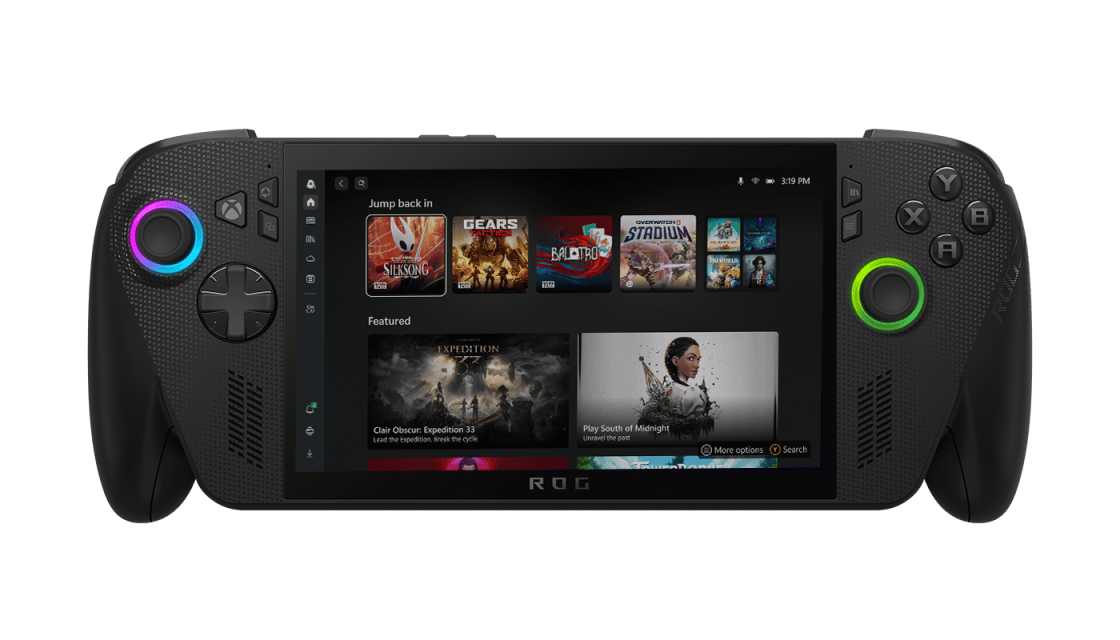Xbox and the future of handheld gaming PCs
The launch of ROG Xbox Ally, expected October 16, may give handheld gaming PCs a boost, but experts don’t expect demand for the minicomputer to explode anytime soon.
The ROG Xbox Ally is the closest thing yet to a portable Xbox console.
The device is the latest handheld gaming PC since the first of its type, Valve’s Steam Deck, was launched in 2022. It’s actually a tiny Windows 11 computer you can carry around to play PC games.
Improved processor, more user-friendly
The ROG Xbox Ally and the more powerful ROG Xbox Ally X are updated versions of the Asus ROG Ally and ROG Ally X, launched in 2023 and 2024, respectively.

Many features, including processors, have been improved, and the devices are more user-friendly. The new controller feels like a real Xbox and, because the weight has been distributed more evenly, it feels lighter in your hands.
The device’s Windows 11 interface has been modified to be reminiscent of the Xbox Series consoles. Not only will users get direct access to PC games from the Xbox store, they can also install software from other app stores, including Steam and Epic Games, easily navigating their way using the familiar Windows 11 interface.
One thing to note, despite having “Xbox” in the name, the ROG Xbox Ally and ROG Xbox Ally X are not compatible with games exclusive to the Xbox One or Xbox Series consoles. However, you can control any Xbox remotely with the device or play Xbox games in the cloud.
Popular, but only with a small crowd
While those who love handheld gaming PCs are devoted, their numbers are small. The International Data Corporation (IDC) estimated in February that less than six million handheld units had been sold between 2022 and 2024, for all brands, worldwide.
For perspective, last year IDC estimated that 65 million gaming PCs would be sold worldwide in 2025. The percentage of players using handheld gaming PCs compared to the total number of conventional gaming PC players is minuscule.
According to information from Montreal-based Behaviour Interactive, less than one percent of gamers playing Dead by Daylight on Steam are doing so on a portable Steam Deck. The vast majority play on a computer or laptop.
Other games are faring slightly better.
“About 4.5 percent of the hours played on our games on Steam this year were played on Steam Deck, a percentage that’s stable since last year,” says Rodrigue Duperron, director of marketing and publishing at Montreal’s Thunder Lotus, the studio behind Spiritfarer, which is available on Steam, and 33 Immortals, which is not.

Spiritfarer is especially well-suited to handheld gaming PCs since the game doesn’t need a ton of power, and its slower pace is easily handled by the console’s built-in controls.
Thunder Lotus is the exception that proves the rule, according to Lewis Ward, author of the IDC report on handheld gaming PCs. “I suppose some studios could see a higher penetration, but it’s less than one percent,” he says.
Ward doesn’t anticipate the upgraded ROG Xbox Ally will do anything to shake up the marketplace, certainly not in the short term. The latest forecast predicts that no more than three million handheld gaming PCs will be sold globally in 2026, all brands included.
“I don’t do a ’27, ’28, ’29 forecast for this, for the very good reason that the numbers are fluctuating all over the place in terms of shipment numbers that we can see,” he says.
If new handhelds with more powerful processors are introduced, the situation could change.
Games are easily adapted
While gamers who opt for handheld PCs may not be large in numbers, they still want games they can play.
“I think there’s a player persona of gamers who are in transit or who travel, and want to bring their gaming library with them. I also hear about people who get them as a curiosity and it ends up becoming their primary gaming platform,” says Scott Christian, director of Toronto-based Hilltop Studios, the creator of Lil’ Guardsman. “I sort of fall into this camp. I bought a Deck to playtest as we developed the new game. Since I bought it, I haven’t touched my Xbox.”
For Christian, it’s essential that Lil’ Guardsman is compatible with the Steam Deck.
Both Steam and Xbox are carefully analyzing games in their stores to see how they perform on handheld gaming PCs.
Valve, Steam’s developer, classifies a game as verified when it’s compatible with the Steam Deck controller, display and operating system. The experience should also be seamless, meaning no compatibility warnings, you must be able to launch it using the controller, and all text should be legible.
In many cases, developers don’t have to do anything to become verified.
“Our games didn’t require any major adaptations to better support handhelds, aside from some extra attention to readability on portable screens,” Duperron confirms in an email. “We had taken this into account for our releases on Nintendo Switch and, in particular, for smartphones long before Steam Deck came along.”
Xbox recently launched the Xbox Handheld Compatibility Program to analyze how games will perform on handheld gaming PCs. Games are evaluated automatically, without developers needing to submit them.
In August, Microsoft published five key guidelines for developers to ensure their games are compatible, with tips on how to comply: games must work by default without gamers having to change settings, iconography must be appropriate for handheld gaming PCs, inputting text must be straightforward on the devices, the interface must be legible from a distance of 12 inches, and the game must be compatible with the device’s resolution.
“The excitement from our developer community has far exceeded our expectations,” says Xbox senior technical program manager Casey Bates. “The work that developers do for this will work for every handheld. It’s going to benefit the entire ecosystem.”



